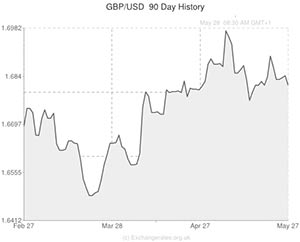
The Pound to US Dollar exchange rate (GBP/USD) tumbled to a 12-day low yesterday as British housing market data underperformed analysts’ expectations and US private sector data printed surprisingly positively.
The British Bankers’ Association (BBA) announced yesterday morning that loans for house purchases fell to their lowest level since August 2013 during April. The drop-off from 45,045 to 42,173 caught traders by surprise because forecasters had originally predicted a higher score of 45,100. It is believed that recent moves from the Bank of England to tighten lending conditions could have contributed to the slowdown in mortgage approvals.
Sterling tumbled across the board in the reaction to the report because the overheating British housing market is seen as one of the primary reasons behind speculation that the BoE will look to start hiking interest rates in the foreseeable future. Therefore it stands to reason that the bank may feel less pressured to raise interest rates if housing market data begins to cool in reaction to targeted initiatives.
Sterling fell by around -0.3 cents against the US Dollar (GBP/USD), -0.2 cents against the Euro (GBP/EUR), -0.3 cents against the Canadian Dollar (GBP/CAD), -0.5 cents against the Australian Dollar (GBP/AUD) and -0.2 cents against the New Zealand Dollar (GBP/NZD) in reaction to the softer-than-anticipated BBA loans for house purchases data.
Nevertheless, mortgage approvals are still up by around 25% from this time a year ago and rapidly increasing house prices could continue to stoke bets of an interest rate ahead of the BoE’s projected date of Q2 2015.
In the United States a selection of positive data releases helped spur demand for the ‘Greenback’.
US durable goods orders confounded expectations of a -0.7% contraction by coming in at +0.8% due to a surge in military aircraft orders.
Service sector output accelerated from 55.6 to a 2-year high of 58.4, which drove Markit’s composite of total private sector activity to a 4-year high of 58.6. The strongest score since April 2010 bolstered demand for the US Dollar because it was seen to augur well for second quarter GDP.
However, the ‘Greenback’ could run into resistance on Thursday when it is predicted that first quarter annualised growth will be revised lower from +0.1% to -0.5%. If the GDP report is downgraded as anticipated then it is entirely possible that we could see Sterling rally back against the US Dollar.
GBP/USD fell through psychological support at 1.6800 during yesterday’s session, but a rebound back towards 1.6900 is possible if first quarter US GDP is taken as a bearish signal for the US Dollar.

Comments are closed.